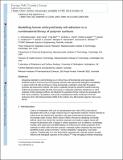| dc.contributor.author | Epa, V. Chandana | |
| dc.contributor.author | Yang, Jing | |
| dc.contributor.author | Mei, Ying | |
| dc.contributor.author | Hook, Andrew L. | |
| dc.contributor.author | Davies, Martyn C. | |
| dc.contributor.author | Alexander, Morgan R. | |
| dc.contributor.author | Winkler, David A. | |
| dc.contributor.author | Anderson, Daniel Griffith | |
| dc.contributor.author | Langer, Robert S | |
| dc.date.accessioned | 2014-10-21T19:29:00Z | |
| dc.date.available | 2014-10-21T19:29:00Z | |
| dc.date.issued | 2012-08 | |
| dc.date.submitted | 2012-07 | |
| dc.identifier.issn | 0959-9428 | |
| dc.identifier.issn | 1364-5501 | |
| dc.identifier.uri | http://hdl.handle.net/1721.1/91142 | |
| dc.description.abstract | Designing materials to control biology is an intense focus of biomaterials and regenerative medicine research. Discovering and designing materials with appropriate biological compatibility or active control of cells and tissues is being increasingly undertaken using high throughput synthesis and assessment methods. We report a relatively simple but powerful machine-learning method of generating models that link microscopic or molecular properties of polymers or other materials to their biological effects. We illustrate the potential of these methods by developing the first robust, predictive, quantitative, and purely computational models of adhesion of human embryonic stem cell embryoid bodies (hEB) to the surfaces of a 496-member polymer micro array library. | en_US |
| dc.language.iso | en_US | |
| dc.publisher | Royal Society of Chemistry | en_US |
| dc.relation.isversionof | http://dx.doi.org/10.1039/c2jm34782b | en_US |
| dc.rights | Creative Commons Attribution-Noncommercial-Share Alike | en_US |
| dc.rights.uri | http://creativecommons.org/licenses/by-nc-sa/4.0/ | en_US |
| dc.source | PMC | en_US |
| dc.title | Modelling human embryoid body cell adhesion to a combinatorial library of polymer surfaces | en_US |
| dc.type | Article | en_US |
| dc.identifier.citation | Epa, V. Chandana, Jing Yang, Ying Mei, Andrew L. Hook, Robert Langer, Daniel G. Anderson, Martyn C. Davies, Morgan R. Alexander, and David A. Winkler. “Modelling Human Embryoid Body Cell Adhesion to a Combinatorial Library of Polymer Surfaces.” J. Mater. Chem. 22, no. 39 (2012): 20902. | en_US |
| dc.contributor.department | Harvard University--MIT Division of Health Sciences and Technology | en_US |
| dc.contributor.department | Massachusetts Institute of Technology. Department of Chemical Engineering | en_US |
| dc.contributor.department | Koch Institute for Integrative Cancer Research at MIT | en_US |
| dc.contributor.mitauthor | Mei, Ying | en_US |
| dc.contributor.mitauthor | Langer, Robert | en_US |
| dc.contributor.mitauthor | Anderson, Daniel Griffith | en_US |
| dc.relation.journal | Journal of Materials Chemistry | en_US |
| dc.eprint.version | Author's final manuscript | en_US |
| dc.type.uri | http://purl.org/eprint/type/JournalArticle | en_US |
| eprint.status | http://purl.org/eprint/status/PeerReviewed | en_US |
| dspace.orderedauthors | Epa, V. Chandana; Yang, Jing; Mei, Ying; Hook, Andrew L.; Langer, Robert; Anderson, Daniel G.; Davies, Martyn C.; Alexander, Morgan R.; Winkler, David A. | en_US |
| dc.identifier.orcid | https://orcid.org/0000-0001-5629-4798 | |
| dc.identifier.orcid | https://orcid.org/0000-0003-4255-0492 | |
| mit.license | OPEN_ACCESS_POLICY | en_US |
| mit.metadata.status | Complete | |
